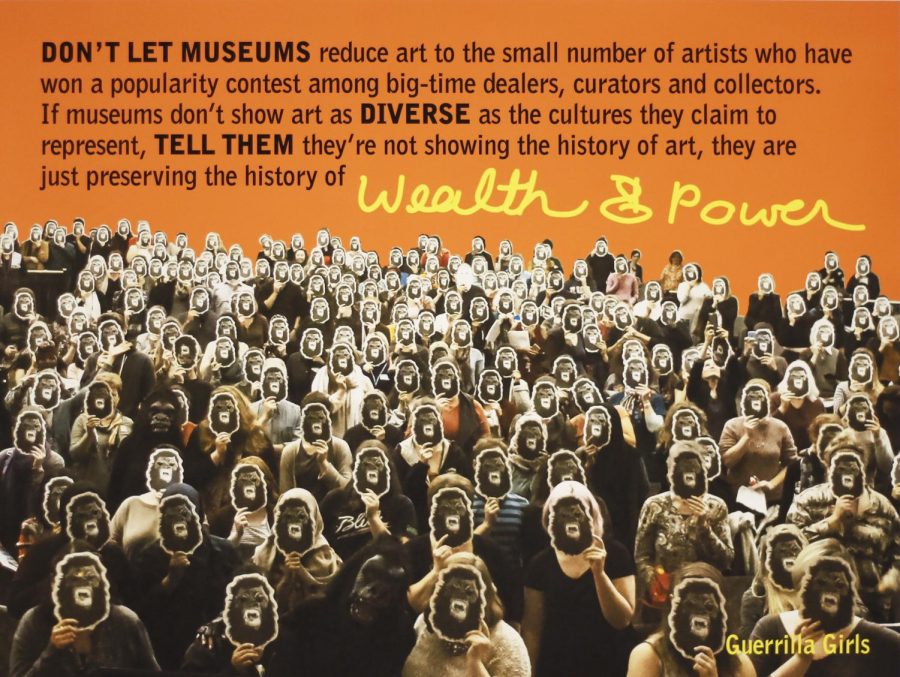‘Guerrilla Girls’ Dare UMOCA Visitors to be Outraged
March 7, 2020
One artist — or rather, one group of around 60 artists — currently dominate the entire first-floor gallery of the Utah Museum of Contemporary Art. They are the “Guerrilla Girls.” Fueled by well-founded anger, the anonymous group made their debut in the late 80s with popular protests against the misogyny so commonplace in the world of art. Their culture-jamming, propaganda-style posters use satire and statistics to condemn gender pay gaps and the exclusion of women by museum curators.
Perhaps the most famous of the Guerrilla Girls’ work is a yellow banner decrying the higher frequency in art museums of naked female subjects than actual female artists. “Do women have to be naked to get into the Met. Museum?” the 1989 sign reads, blown up to cover an entire wall of the UMOCA. Their exhibit here in Salt Lake City winds us through time, taking visitors from the Guerrilla Girl’s inception in 1985 to works of theirs as recent as 2016, tracking changes — or the lack thereof — in female representation in art. While the targets of their protest may have shifted from the Metropolitan Museum to the Academy Awards or Newt Gingrich to Donald Trump, their message remains the same — if we are not making space for women and people of color in our celebrations of art, then we are not celebrating art, we are celebrating power.
Anger, Art and Aggression
Beyond their creative critiques of the patriarchy, the Guerrilla Girls offer a meta look at the role of anger in art-making. Their work — loud, blunt and leaving little to the imagination — challenges our expectations of what walking through a museum should feel like. We tend to treat art as a sort of escape. Whether it’s a Georgia O’Keefe painting or “Guardians of the Galaxy” movie, the experience of art often carries the expectation that we will be distracted or carried away from our normal lives.
But the Guerrilla Girls do quite the opposite. They create in order to expose, in the harshest light possible, the systemic cruelty behind what we consider normal. While aggression is encouraged in men from birth, it’s all but nonexistent in society’s ideal woman. These masked artists offer no apologies in their depiction of the modern woman’s subjugation. The result is an experience that feels dismal and oppressive. Due to its abrasive approach, not everyone considers themselves fans of the Guerrilla Girls experience.
Representation vs. Marginalization
Although it may not be the most pleasant of art museum strolls, I think that’s the intention. Walking through the exhibit, it was near-impossible for me to shake a sense of hopelessness, the same hopelessness that drove the creation of the art in the first place. As a cisgender man, I will only ever experience misogyny secondhand through the voices of the women brave enough to share. This exhibit communicated feelings I am privileged enough to never know and thus obligated to listen to.
One criticism I have heard of the Guerrilla Girls includes the membership’s relative silence on transphobia and homophobia within the art industry, leaving some to wonder if their self-proclaimed “intersectional feminism” is “intersectional” in anything other than name. While I would have liked to see the incorporation of wider gender conversations into the Guerrilla Girls’ art, I am wary of using that argument to criticize them. Don’t other artists also share the responsibility in making space for underrepresented people? Besides, maybe the Guerrilla Girls’ purpose is not to perfectly articulate the marginalization of all minority groups, but to spark new and necessary discourses. Maybe their purpose is simply to validate female anger, to let it flow unrestrained.
“Guerrilla Girls” opened at the UMOCA on Feb. 7, 2020 and will be on display until June 6, 2020. The museum is free and open to the public, although the organization is a non-profit and asks for an optional $8 donation at the door. Those considering visiting should be aware that the exhibit contains casual, non-graphic references to sexual harassment, sexual assault and rape. See more information on the exhibit here.
For those interested in hearing from a Guerrilla Girls member herself, the UMOCA will be hosting a public lecture with artist Käthe Kollwitz on Monday, March 9, 2020. Check out more information on the event or purchase tickets here.








